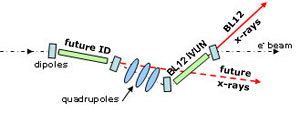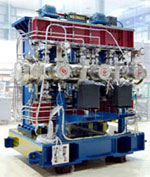

Contents of this Issue:
1. Science Highlight —
Insight into Lead Toxicity
(contact:
J.E. Penner-Hahn, jeph@umich.edu)
 |
To learn more about this research published in the July 6, 2005 issue of the
Journal of the American Chemical Society see:
http://www-ssrl.slac.stanford.edu/research/highlights_archive/pb-ii.html
http://www-ssrl.slac.stanford.edu/research/highlights_archive/pb-ii.pdf
2. Science Highlight —
Using X-ray Diffraction to See beyond the Smoke
(contact:
C.D. Stout, dave@scripps.edu)
 |
Their studies have revealed in fine detail the exact active site structure of the enzyme. This structural information is being used in ongoing high-resolution macromolecular crystallography experiments at SSRL to probe the active site of this P450 2A6 with additional small molecule compounds. These studies may ultimately lead to the design of an effective inhibitor of P450 2A6 that could be used to decrease the occurrence of smoking and tobacco-related cancers by reducing dependence on nicotine and by blocking formation of carcinogens.
To learn more about this research published in the September 2005 issue of Nature Structural & Molecular Biology see:
http://www-ssrl.slac.stanford.edu/research/highlights_archive/CYP2A6.html
http://www-ssrl.slac.stanford.edu/research/highlights_archive/CYP2A6.pdf
(see also: The Scripps Research Institute press release by
Jason Bardi
http://www.scripps.edu/news/press/082605.html)
3. Holiday Greetings from the Director
 |
On June 20 a significant milestone was achieved when SPEAR3 reached 500 mA for the first time. Subsequent accelerator physics periods have been used to store high current in SPEAR3 and operate Beam Line 6-2 at 500 mA. Completion of a series of beam line upgrades is the next step towards 500 mA user operations and steady progress has been made on Beam Lines 2, 7, 9 and 10 with users expected on these beam lines early in the new year. The accelerator group successfully tested a new double-focus chicane, installed in the long east-pit straight section of SPEAR3, that will be used as the source point for the new in vacuum undulator structural biology Beam Line 12 (see item 4 below).
Another major event was the 27th International Conference on Free Electron Lasers, FEL2005, held in August and hosted by the LCLS and SSRL. A broad spectrum of topics was covered as about 300 participants gathered to participate in lectures, discussions and poster sessions. SSRL looks forward to hosting an equally successful 13th International Conference on X-ray Absorption Fine Structure (XAFS13) at Stanford in July 2006 (see the announcement later in this newsletter).
October 2005 brought changes in the SSRL directorate. I became the 4th SSRL
Director and Britt Hedman and Piero Pianetta jointly were appointed SSRL Deputy
Directors. The new management structure can be viewed on the web under
http://www-ssrl.slac.stanford.edu/psd_organization_functional_v56.pdf.
During 2005, SSRL's Sub-Picosecond Pulse Source (SPPS) led by Jerry Hastings continued to produce exciting scientific results which were published in premier scientific journals. Details can be found at http://www-ssrl.slac.stanford.edu/jbh/. SPPS also serves as a stepping stone and training ground for the most exciting source yet to come, the Linac Coherent Light Source (LCLS). LCLS is well on track for first light in 2008, assigned to receive its full 2006 construction budget of about $80M.
I thank those who serve on SSRL's advisory committees - the Proposal Review Panel (PRP), the SMB Advisory Committee and the SSRL Users' Organization Executive Committee for their tireless work and advice. Guidance from these groups is extremely important to help us plan and move forward in the wisest and most effective ways. These advisory committees will be complemented in 2006 by a Scientific Advisory Committee (SAC), which initially will be composed of the full PRP plus additional international experts. The role of the SAC is to advise SSRL management on issues relating to the operation of SSRL as a scientific user facility and the long-term scientific directions of SSRL, including the planning and construction of new SSRL facilities.
We continue to be grateful to our funding agencies - the Department of Energy's Office of Basic Energy Sciences for providing the core operations funding and support for materials research and the DOE Office of Biological and Environmental Research and the National Institutes of Health NIGMS and NCRR Programs for support of the structural biology program. Without their effective support, we would not be able to push the scientific forefront and effectively serve our large and growing user community.
I urge you to continue to let us know your opinions and ideas - it helps us serve you better, improve our operations and plan for the future. In closing, on behalf of SSRL and its staff, let me extend our very best wishes to all of you for the holiday season and for 2006!
—Jo Stöhr, SSRL Director
4.
Double-focus Lattice Configuration Successfully Tested
(contacts: W.J.
Corbett, corbett@slac.stanford.edu; R. Hettel, hettel@slac.stanford.edu)
 |
|
| Figure 1: Schematic of double-focus chicane with 10-mrad photon beam separation in SPEAR east long straight section (IVUN = in-vacuum undulator). | |
 | |
| Figure 2: In-vacuum undulator similar to that for BL12. | |
 | |
| Figure 3: Double-focus quadrupole triplet in the SPEAR east straight section. | |
5.
New SSRL Faculty Member
(contact: B.
Hedman, hedman@ssrl.slac.stanford.edu)
 | |
| Ed Solomon |
6.
SLAC Policy Committee Meeting on December 2-3, 2005
(contact:
K. Hodgson, hodgson@ssrl.slac.stanford.edu)
The meeting of the SLAC Policy Committee in early December was the first to be held with the recently revised charter that incorporates a stronger oversight role in management and environmental health and safety. This expanded role is in addition to the advice on science policy and strategic planning by the SPC. At this meeting, the SPC heard about operations during the first 6 months under the new SLAC management organization. In the Photon Science area, Keith Hodgson described the new organization and its three main elements (SSRL, the ultrafast center, and the LUSI project). Other Photon Science activities included presentations by SSRL Director Jo Stöhr on the state of SSRL, by Jerry Hastings on the LUSI project, by Keith Hodgson (representing Phil Bucksbaum) on the ultrafast science center, and by SSRL faculty chairperson Gordon Brown, Jr. on the next five-year faculty development plan. The newly formed ES&H Advisory Committee (ESHAC) reported out formally to the SPC. At the next meeting of the ESHAC, they plan to examine the user safety programs in more detail. Overall, the SPC seemed pleased with the progress and new management. The SPC reported out to Provost Etchemendy and Vice-Provost Bienenstock at the end of the two-day meeting.
| 7. |  | to be Held at Stanford July 9-14, 2006 |
| (contacts: B. Hedman, hedman@ssrl.slac.stanford.edu; P. Pianetta, pianetta@ssrl.slac.stanford.edu) | ||
SSRL is pleased to announce that the 13th International Conference on X-ray Absorption Fine Structure (XAFS13) will be held at Stanford, CA during the week of July 9-14, 2006. It is hosted by Stanford University and Stanford Synchrotron Radiation Laboratory. The conference venue will be on Stanford University campus in the Frances C. Arrillaga Alumni Center. The XAFS Conference constitutes an international series held every three years. The latest two XAFS conferences took place in Malmö, Sweden (2003) and Ako, Japan (2000). The scope of the conference is X-ray Absorption Fine Structure and related techniques and topics. Many techniques and the theory focusing on XAFS-related phenomena will be covered, as will applications to a wide range of scientific areas. A web site: http://www-ssrl.slac.stanford.edu/xafs13 will be continuously updated as information becomes available. Queries can be sent to the email address xafs13@ssrl.slac.stanford.edu. We look forward to your participation in this conference and seeing you here at Stanford in 2006!
8.
Photon Science Job Opportunities
A number of positions are currently available at LCLS and SSRL. Please refer
to the Photon Science Job Openings page at for more information about these job
opportunities.
http://www-ssrl.slac.stanford.edu/photonscience/jobs.html
__________________________________________________________________________
SSRL Headlines is published electronically monthly to inform SSRL users, sponsors and other interested people about happenings at SSRL. SSRL is a national synchrotron user facility operated by Stanford University for the U.S. Department of Energy Office of Basic Energy Sciences. Additional support for the structural biology program is provided by the DOE Office of Biological and Environmental Research, the NIH National Center for Research Resources and the NIH Institute for General Medical Sciences. Additional information about SSRL and its operation and schedules is available from the SSRL WWW site.
__________________________________________________________________________
To leave the SSRL-HEADLINES distribution, send email as shown below:
To: LISTSERV@SSRL.SLAC.STANFORD.EDU Subject: (blank, or anything you like)
The message body should read
SIGNOFF SSRL-HEADLINES
That's all it takes. (If we have an old email address for you that is forwarded to your current address, the system may not recognize who should be unsubscribed. In that case please write to ssrl-headlines-request@ssrl.slac.stanford.edu and we'll try to figure out who you are so that you can be unsubscribed.)
If a colleague would like to subscribe to the list, he or she should send To: LISTSERV@SSRL.SLAC.STANFORD.EDU and use the message body
SUBSCRIBE SSRL-HEADLINES
|
SSRL Welcome
Page | Research
Highlights | Beam Lines | Accel
Physics
User Admin | News & Events | Safety Office |